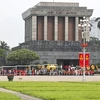
Hanoi (VNA) – Becoming a member of the UNESCO Creative Cities Network is the first but significant step for Hanoi to raise its standing and create a new and more attractive image of the city.
According to the municipal Department of Culture and Sports, Hanoi was designated as part of the UNESCO Creative Cities Network on October 30.
The Vietnamese capital became a new member of the network in the field of design, through which it will take part in the promotion of international cooperation among cities in the network with a view to utilising cultural and creative resources as the basis for sustainable urban development.
The department said with the vision and brand of a creative city in terms of design, Hanoi can strengthen its competitiveness in large-scale investment attraction, stimulate urban renewal, and concentrate educational development programmes and cultural events that are associated with the vision for sustainable development.
To realise its commitment to the network, Hanoi will issue a long-term action programme and connect its policies to promote cultural industries and enrich local cultural resources. It will also create prerequisites to help other cities of Vietnam to take part in the Creative Cities Network and actively contribute to the network’s development, thereby affirming its stature as the creative capital of Vietnam in Southeast Asia and the world.
[Infographics: Hanoi - City for Peace]
The authorities noted Hanoi is the political – administrative centre and a major hub in terms of culture, science, education, economy and international transactions of Vietnam. The city also boasts historical and cultural quintessence as seen through a number of national and international tangible and intangible cultural heritages, along with hundreds of traditional craft villages.
Additionally, it gathers talents and intellectuals from across the country in research centres, academies, universities and colleges, which is a favourable condition for it to receive and popularise knowledge and new technology which are important factors in the development of cultural and creative industries.
Being a member of the UNESCO Creative Cities Network is a good chance for Hanoi to popularise its image in all the fields of creation and culture.
The department noted that although Hanoi is strong at many fields of creativity, it decided to apply for the status in terms of design since this area has wide coverage, is closely linked with other fields, and can reflect the city’s potential and strength in bringing into play its creativity.
Besides, the capital city has also met the standards for a creative city of design, including a developed design industry, multiple opportunities for creating designs from natural materials and conditions, and the presence of design groups with frequent activities.
A total of 66 cities were designated as UNESCO Creative Cities on this occasion. Apart from Hanoi, the seven other creative cities of design are Asahikawa (Japan), Baku (Azerbaijan), Bangkok (Thailand), Cebu City (the Philippines), Muharraq (Bahrain), Querétaro (Mexico), and San José (Costa Rica).
“All over the world, these cities, each in its way, make culture the pillar, not an accessory, of their strategy,” says UNESCO Director-General Audrey Azoulay. “This favours political and social innovation and is particularly important for the young generations.”
The network’s creative fields consist of literature, design, craft and folk arts, film, music, media arts, and gastronomy.
The UNESCO Creative Cities Network, founded in 2004, aims to enhance cooperation among cities which recognised creativity considered a strategic factor of sustainable development. Its membership has reached 246 at present.
The member cities that form part of the network come from all continents and regions with different income levels and populations. They work together towards a common mission: placing creativity and the creative economy at the core of their urban development plans to make cities safe, resilient, inclusive and sustainable, in line with the United Nations 2030 Agenda for Sustainable Development./.
























